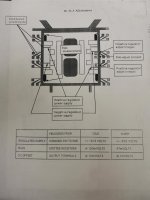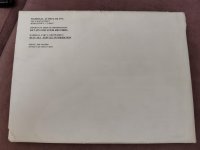...That ML326S was the same as my ML320 but with Arlon boards.
Arlon was the successor of the previous less successful Teflon.
As said, fantastic looks, love at first sight but not top of the bill in sound despite the use of expensive components ...
Hans, you've probably heard a lot of amps. What's your optinion of the 27.5 in general, or compared to the 20.6 monoblocks? Are you listening with electrostats? Have you listened to any contemporary amps that you consider superior in sound?
BR
I have heard a lot of amps, that’s true although never a tube amp and never a class D.
And there are new amps coming to the market all the time that are not available for auditioning in your own set.
But of all the amps I have heard I was always pleased the most with class A amps such as the 20.6 but the 27.5 and the 23.5 are worthy family members.
I never was impressed by the later ML amps.
And with my modernised 20.6 I think that I can succesfuly compete in the top league 😀😀
And yes, I have those wonderful ESL63 speakers that are very revealing and I play a lot of LP’s.
Hans
And there are new amps coming to the market all the time that are not available for auditioning in your own set.
But of all the amps I have heard I was always pleased the most with class A amps such as the 20.6 but the 27.5 and the 23.5 are worthy family members.
I never was impressed by the later ML amps.
And with my modernised 20.6 I think that I can succesfuly compete in the top league 😀😀
And yes, I have those wonderful ESL63 speakers that are very revealing and I play a lot of LP’s.
Hans
That you cannot audition stuff in your own set and room 'prevents' me from finding a better system (if there even is one ;-) Buying stuff new just for auditioning and then selling it is a sure way to loose money. It works so so with used components, but finding a seller (who then typically lives far away) is a chore.
That's why I'm interested in opinion.
BR
That's why I'm interested in opinion.
BR
I can say that the ml27. 5 is a great amplifier. His sound signature is amazing. Incredible depth, scale and melody on any music. I don't even have anything to compare it with, since I didn't hear anything similar in sound. You know how the Americans write: "I will never part with this amplifier, I will be buried in the same grave with it")
And yes, I have those wonderful ESL63 speakers that are very revealing and I play a lot of LP’s.
The ESL63 also need a a fair deal of care (glue getting brittle) I'm hearing. I'm on a coax+bassreflex system from a regional studio monitor designer, and, while I like it, ESLs are something I'm going to try out some time (room placement being a concern). The only class A I had so far was the integrated Pioneer A-27, which left me a bit disappointed (could be because the speakers didn't fit well).
@M.L. I tend to agree, but then again, have you listened to a 20.6 with electrostats?
Anyway, I'm getting carried away.
BR
Last edited:
In the meantime, I'm chewing through this (great) LTSpice tutorial in the forum and am wondering if I could simulate the 27.5, starting with the regulator, voltage & current gain.
That would come in handy should I break something while dismantling the amp.
BR
That would come in handy should I break something while dismantling the amp.
BR
I have heard a lot of amps, that’s true although never a tube amp and never a class D.
And there are new amps coming to the market all the time that are not available for auditioning in your own set.
But of all the amps I have heard I was always pleased the most with class A amps such as the 20.6 but the 27.5 and the 23.5 are worthy family members.
I never was impressed by the later ML amps.
And with my modernised 20.6 I think that I can succesfuly compete in the top league 😀😀
And yes, I have those wonderful ESL63 speakers that are very revealing and I play a lot of LP’s.
Hans
Hans, good afternoon! What do you think for 27.5 the same current settings as for 23.5 ?
Attachments
Nice table but not correct IMO.
Bias current for the 23.5 is 270mA flowing through 6 pairs of output transistors.
That’s 45mA/transistor.
With 0.22R emitter resistors this means 9.9mV per emitter resistor and not 47mV.
So the 47mV in your table should be read as 47mA.
The same amount of current should also flow per transistor in the 27.5
With 4 pairs of output transistors this adds up to 180mA.
Since all the emitter transistors are joined in four 0.22R that are two by two in parallel, they act as two 0.11R resistors.
So you can also measure here to see 180mA times 0.11R is 19.8 mV or 39.6 mV if you measure over the 2x0.11R.
Hans
Bias current for the 23.5 is 270mA flowing through 6 pairs of output transistors.
That’s 45mA/transistor.
With 0.22R emitter resistors this means 9.9mV per emitter resistor and not 47mV.
So the 47mV in your table should be read as 47mA.
The same amount of current should also flow per transistor in the 27.5
With 4 pairs of output transistors this adds up to 180mA.
Since all the emitter transistors are joined in four 0.22R that are two by two in parallel, they act as two 0.11R resistors.
So you can also measure here to see 180mA times 0.11R is 19.8 mV or 39.6 mV if you measure over the 2x0.11R.
Hans
Understood, thank you for your clarification. Look what I have a rarity)Nice table but not correct IMO.
Bias current for the 23.5 is 270mA flowing through 6 pairs of output transistors.
That’s 45mA/transistor.
With 0.22R emitter resistors this means 9.9mV per emitter resistor and not 47mV.
So the 47mV in your table should be read as 47mA.
The same amount of current should also flow per transistor in the 27.5
With 4 pairs of output transistors this adds up to 180mA.
Since all the emitter transistors are joined in four 0.22R that are two by two in parallel, they act as two 0.11R resistors.
So you can also measure here to see 180mA times 0.11R is 19.8 mV or 39.6 mV if you measure over the 2x0.11R.
Hans
Attachments
How did you get your hands on this? Did you take over a dealership? Or one went bankrupt and sold their shop inventory? 🙂
Perhaps you would be inclined to scan in this stuff for cookie points?
BR
Perhaps you would be inclined to scan in this stuff for cookie points?
BR
Be aware that this is ML20 documentation.
Hans
Gotcha! I read 20-20.6 and somehow thought it is for the whole 2x series 🙄
BR
The glitch just appeared for 5sec (left channel gain down) and as a result the turquoise graph in scope picture above went flat. Couldn't screenshot b/c it lasted only 5 sec.
So, there is a problem with P7 Neg_Drive.
I will next see if the glitch concurs with a problem of Neg_V_Reg, because that easy to check (although, in that case the protection should kick in?)
Could be either Bourns on Neg_V_Reg or Buffer (R59), or a cold solder. Although the pods have been moved back and forth.
BR
PS: in case anyone wonders, I want to keep at least one ML operational all the time, that's why I went down this path first before dismantling the other one to change components properly.
So, there is a problem with P7 Neg_Drive.
I will next see if the glitch concurs with a problem of Neg_V_Reg, because that easy to check (although, in that case the protection should kick in?)
Could be either Bourns on Neg_V_Reg or Buffer (R59), or a cold solder. Although the pods have been moved back and forth.
BR
PS: in case anyone wonders, I want to keep at least one ML operational all the time, that's why I went down this path first before dismantling the other one to change components properly.
Last edited:
It can't be the Neg_V_Reg because the +- 1,75V on +-Drive are maintained when going flat.
So the problem is either in the voltage gain or buffer.
So the problem is either in the voltage gain or buffer.
To be honest, I find it a bit hard to understand what you are doing or what you are trying to investigate.
Hans
Hans
Left channel sometimes goes mute, not fully, you still hear something, but very muted compared to right channel. I cannot provoke it, it's like a warm-up issue.
I traced the problem to P7. If the glitch happens, P7 shows a flat line (at about -1,75V) while P6 still shows the sine wave from the input signal. You're with me?
From there, I am trying to trace the glitch back.
BR
I traced the problem to P7. If the glitch happens, P7 shows a flat line (at about -1,75V) while P6 still shows the sine wave from the input signal. You're with me?
From there, I am trying to trace the glitch back.
BR
- Home
- Amplifiers
- Solid State
- Mark Levinson No.27 amplifier,,,NEED HELP



